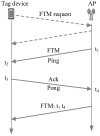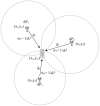A Survey of Smartphone-Based Indoor Positioning System Using RF-Based Wireless Technologies
- PMID: 33348701
- PMCID: PMC7767154
- DOI: 10.3390/s20247230
A Survey of Smartphone-Based Indoor Positioning System Using RF-Based Wireless Technologies
Abstract
In recent times, social and commercial interests in location-based services (LBS) are significantly increasing due to the rise in smart devices and technologies. The global navigation satellite systems (GNSS) have long been employed for LBS to navigate and determine accurate and reliable location information in outdoor environments. However, the GNSS signals are too weak to penetrate buildings and unable to provide reliable indoor LBS. Hence, GNSS's incompetence in the indoor environment invites extensive research and development of an indoor positioning system (IPS). Various technologies and techniques have been studied for IPS development. This paper provides an overview of the available smartphone-based indoor localization solutions that rely on radio frequency technologies. As fingerprinting localization is mostly accepted for IPS development owing to its good localization accuracy, we discuss fingerprinting localization in detail. In particular, our analysis is more focused on practical IPS that are realized using a smartphone and Wi-Fi/Bluetooth Low Energy (BLE) as a signal source. Furthermore, we elaborate on the challenges of practical IPS, the available solutions and comprehensive performance comparison, and present some future trends in IPS development.
Keywords: Bluetooth low energy; Wi-Fi; fingerprinting localization; indoor positioning system; performance metrics; positioning algorithms.
Conflict of interest statement
The authors declare no conflict of interest.
Figures












Similar articles
-
On Indoor Localization Using WiFi, BLE, UWB, and IMU Technologies.Sensors (Basel). 2023 Oct 20;23(20):8598. doi: 10.3390/s23208598. Sensors (Basel). 2023. PMID: 37896691 Free PMC article.
-
MagIO: Magnetic Field Strength Based Indoor- Outdoor Detection with a Commercial Smartphone.Micromachines (Basel). 2018 Oct 20;9(10):534. doi: 10.3390/mi9100534. Micromachines (Basel). 2018. PMID: 30424467 Free PMC article.
-
Indoor Localization Methods for Smartphones with Multi-Source Sensors Fusion: Tasks, Challenges, Strategies, and Perspectives.Sensors (Basel). 2025 Mar 14;25(6):1806. doi: 10.3390/s25061806. Sensors (Basel). 2025. PMID: 40292946 Free PMC article. Review.
-
Ultra-Low-Power, High-Accuracy 434 MHz Indoor Positioning System for Smart Homes Leveraging Machine Learning Models.Entropy (Basel). 2021 Oct 25;23(11):1401. doi: 10.3390/e23111401. Entropy (Basel). 2021. PMID: 34828099 Free PMC article.
-
A Survey of Latest Wi-Fi Assisted Indoor Positioning on Different Principles.Sensors (Basel). 2023 Sep 18;23(18):7961. doi: 10.3390/s23187961. Sensors (Basel). 2023. PMID: 37766018 Free PMC article. Review.
Cited by
-
An Automated Indoor Localization System for Online Bluetooth Signal Strength Modeling Using Visual-Inertial SLAM.Sensors (Basel). 2021 Apr 19;21(8):2857. doi: 10.3390/s21082857. Sensors (Basel). 2021. PMID: 33921567 Free PMC article.
-
A Survey of the Performance-Limiting Factors of a 2-Dimensional RSS Fingerprinting-Based Indoor Wireless Localization System.Sensors (Basel). 2023 Feb 24;23(5):2545. doi: 10.3390/s23052545. Sensors (Basel). 2023. PMID: 36904748 Free PMC article. Review.
-
An Indoor Location-Based Augmented Reality Framework.Sensors (Basel). 2023 Jan 26;23(3):1370. doi: 10.3390/s23031370. Sensors (Basel). 2023. PMID: 36772414 Free PMC article.
-
Positioning in 5G and 6G Networks-A Survey.Sensors (Basel). 2022 Jun 23;22(13):4757. doi: 10.3390/s22134757. Sensors (Basel). 2022. PMID: 35808254 Free PMC article. Review.
-
Federated Learning Framework for Real-Time Activity and Context Monitoring Using Edge Devices.Sensors (Basel). 2025 Feb 19;25(4):1266. doi: 10.3390/s25041266. Sensors (Basel). 2025. PMID: 40006493 Free PMC article.
References
-
- GPS GPS: The Global Positioning System. [(accessed on 28 August 2020)];2020 Available online: https://www.gps.gov/
-
- Information Analytical Centre of GLONASS and GPS Controlling. [(accessed on 28 August 2020)];2020 Available online: https://www.glonass-iac.ru/en/
-
- European GNSS Service Centre|European GNSS Service Centre. [(accessed on 28 August 2020)];2020 Available online: https://www.gsc-europa.eu/
-
- BeiDou Navigation Satellite System. [(accessed on 28 August 2020)];2020 Available online: http://en.beidou.gov.cn/
-
- Vasisht D., Kumar S., Katabi D. Decimeter-level localization with a single WiFi access point; Proceedings of the 13th USENIX Symposium on Networked Systems Design and Implementation (NSDI ’16); Santa Clara, CA, USA. 17–18 March 2016; pp. 165–178.
Publication types
Grants and funding
LinkOut - more resources
Full Text Sources
Other Literature Sources
Research Materials

